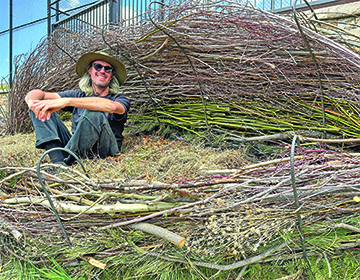By Laura Lieff
 In the gardening world, just because something is decaying does not mean it’s unusable. Constructed in less than a week by Kevin Philip Williams, Manager of Horticulture at Denver Botanic Gardens (DBG), the dead hedge installation can be found in the Pollinator Garden at Betty Ford Alpine Gardens.
In the gardening world, just because something is decaying does not mean it’s unusable. Constructed in less than a week by Kevin Philip Williams, Manager of Horticulture at Denver Botanic Gardens (DBG), the dead hedge installation can be found in the Pollinator Garden at Betty Ford Alpine Gardens.
Comprised of various layered, locally- sourced materials — including branches, plant debris, and small logs that are in different stages of decay, as well as willows from Vail, alpaca wool from McCoy, and trees cut in the Gardens — the installation was executed with a great deal of intention. “With the help of some friends and volunteers from both Eagle County and Denver, Kevin’s piece was constructed very quickly,” says Gardens Education Director Gabe Starr. “We appreciate Denver Botanic Gardens ‘lending’ us Kevin for the week!”
Since mountain landscapes differ from city landscapes, the materials differ as well. At the Gardens, Williams incorporated brush piles, dead hedges, and log walls into the exhibit space in ways he says are “ascetically accepted by the public.” He goes on to explain that “there are many practitioners who are elevating garden design horticulture to a level of fine art” and that his work is “new, experimental, and different than traditional horticulture.”
Visitors will notice that the installation resembles an animal habitat — except it is a much more upscale, artistic version. By mixing the log walls into the woven structure — which is comprised of rolled and bound branches, as well as the aforementioned materials — his installation connects with this summer’s theme of Habitat in conjunction with the installation of our exhibit from the Smithsonian Gardens and Smithsonian Institution Traveling Exhibition Service.
In addition to the Habitat theme, Williams explains that many aspects of the project were inspired by the long, narrow space provided. “I try to bring new elements to each install and this space allowed us to play with length and dimensionality,” he adds. In fact, he describes it as a “calcified exoskeleton type of structure that features crevices filled with grasses, branches, and leaves held by the harder outer structure.”
Williams has an MS in Public Horticulture and is a naturalistic garden designer who uses active and passive materials to create dynamic and climate-appropriate gardens. His work includes the Denver Art Museum Sensory Garden, the Alien Dream Worlds and Hello Food Forest at Meow Wolf, and the Abstract Expressions installation at the Clifford Still Museum. He also co-wrote a book called Shrouded In Light: Naturalistic Planting Inspired by Wild Shrublands.
Williams adds, “These installations take an incredible amount of material to create and the Gardens staff did a good job saving materials from around town which allowed us to give discarded branches and forgotten debris a second life as art. In nature, nothing is ever truly waste — it’s simply matter waiting for its next beautiful purpose.” For more information, visit bettyfordalpinegardens.org.

Comments are closed.